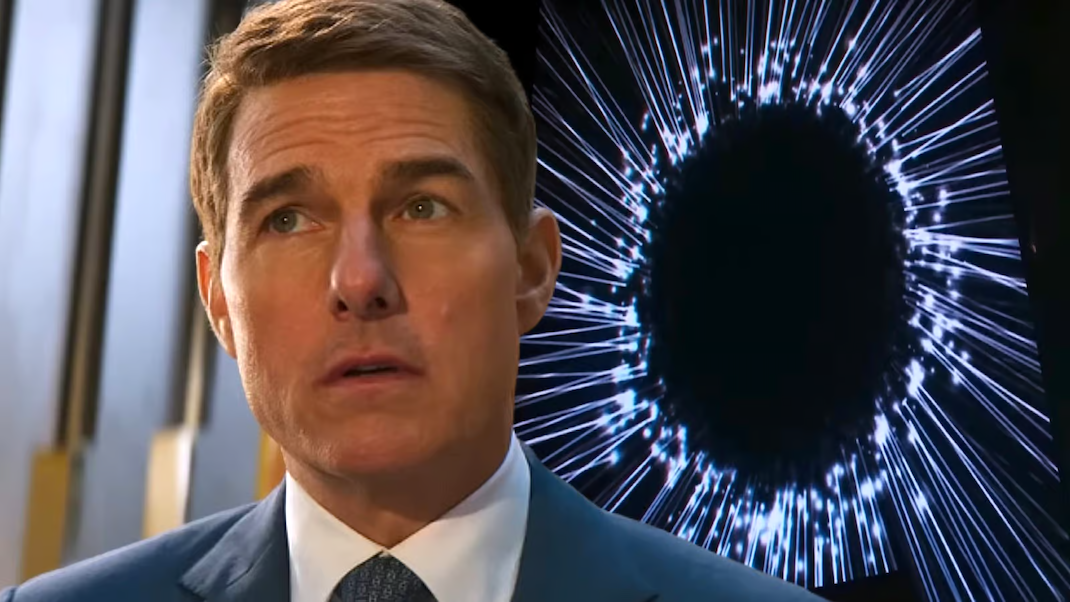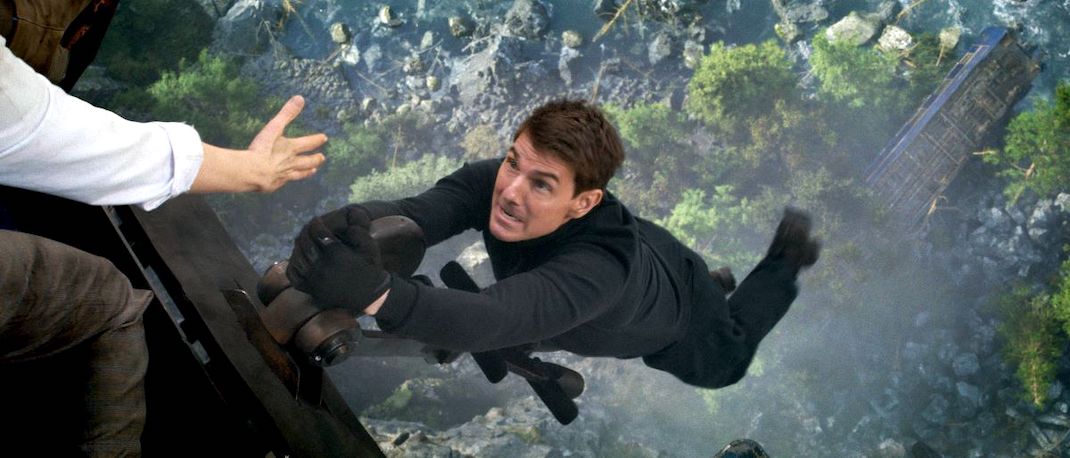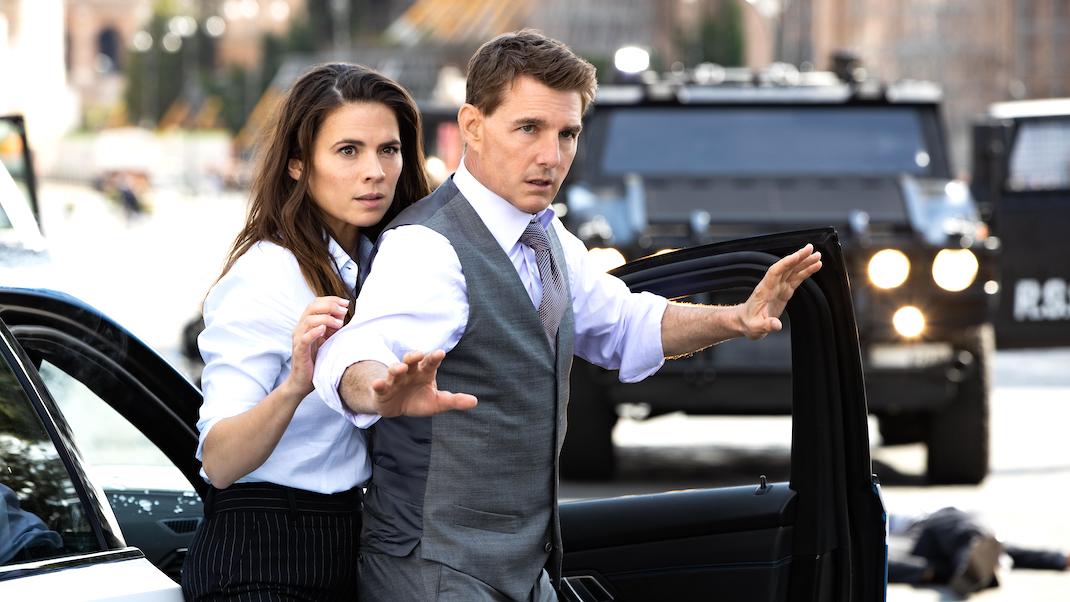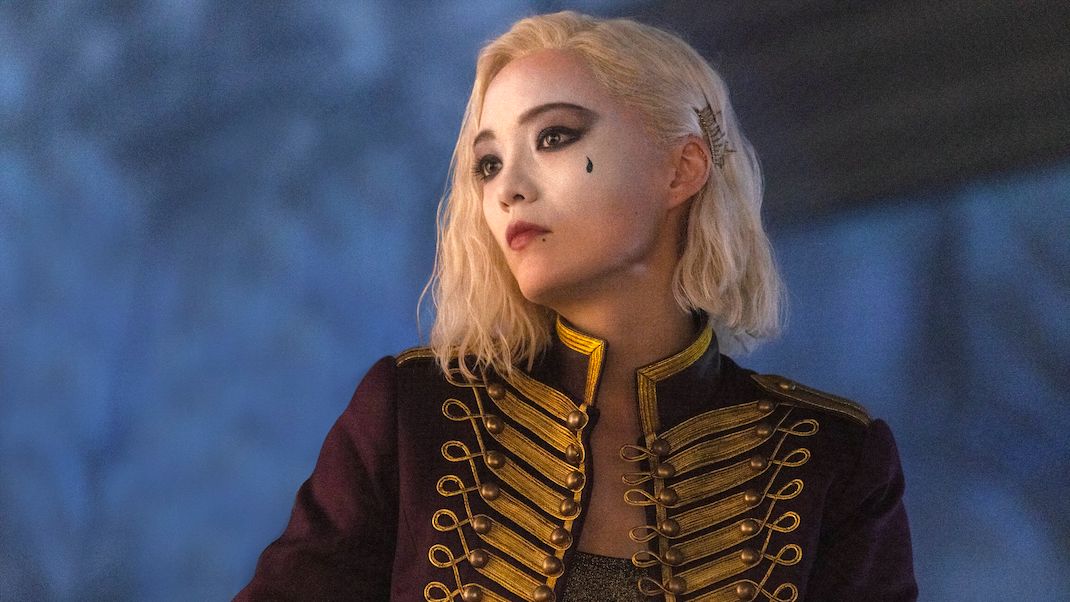Mission: Impossible – Dead Reckoning, Part One is part of My Summer of Summer Movies, in which I am attempting to see and review every movie that opens (in Chicago) between Memorial Day and Labor Day, 2023. Read all about this ill-advised plan here.
I am neither a particular fan nor a particular foe of the Mission: Impossible franchise. I am just a bit too young to remember much about the TV show (1966–1973)— except for its iconic theme music—and I certainly never had any nostalgic affection for it. (Did anyone?) I think I have seen all the films (seven to date, starting in 1996), but it scarcely matters. (Did I ever see the third one? Who can say for sure?) I know I enjoyed some of them. (Ghost Protocol was pretty good, wasn't it? Was that the one with the sandstorm?) But I couldn't really tell you much of anything about any of them. I remember a couple of stunts and set-pieces, but I couldn't tell you which installments produced them, or what convoluted plots they serviced. I know the name of Tom Cruise's character (Ethan Hunt, right?), and I could name a bunch of other actors who have appeared in at least some of the movies, but for the life of me I couldn't tell you which movies they were in or what their characters were called.
So my experience with the Mission: Impossible movies has been that they are just there: the worst of them were utterly forgettable—and I have utterly forgotten them, to prove it—but even the best of them were just well-made, vaguely entertaining to watch, and kind of disposable. Let's say I've seen five or six of them, and I liked them well enough. (I like roller-coasters, too, and I've probably ridden five or six of those in my life as well, but I couldn't tell you what they were called, nor have I retained any specific details of their particular tracks and turns. Why would I?)
So I wasn't exactly dreading watching Christopher McQuarrie's Mission: Impossible – Dead Reckoning, Part One, but I wasn't exactly looking forward to it either. On the plus side, I assumed there would be good action sequences. On the negative side, the movie was nearly as long as its title—a mind- and ass-numbing 163 minutes—and that's a long time to sit through anything, let alone the seventh installment of an action franchise that had failed five or six times before to ever engage me emotionally. (Perhaps worst of all, this one would be uniquely demanding in that I was actually going to have to think of something to say about it, owing to My Summer of Summer Movies review marathon.)
To add insult to injury, it was pouring rain on the day I went to see it, and I had to make my way across a poorly-drained multiplex courtyard, which meant I was going to be sitting through an intolerably long movie, in which I had no particular investment, and which I expected to be utterly forgettable, in very wet socks.
So I just want to be clear: I arrived at my screening unexcited, unmotivated, uninvested, a little uninformed, undeniably cranky, and uncomfortably damp.
And I've told you all of that merely to tell you this: Nearly three-and-a-half hours later (2:43 of movie, plus an endless array of previews), the credits rolled on Mission: Impossible – Dead Reckoning, Part One, and I was disappointed it was over. In fact, I would gleefully have stayed in my seat another three-and-a-half hours—wet socks and all—to watch Mission: Impossible – Dead Reckoning, Part Two, right there and then, if that option had been on offer.
That's how much fun I had.
Let us dispense, as quickly as possible, with the plot. In a franchise that has been overcrowded with rogue agents and rogue assassins and rogue nations, there is now a rogue artificial-intelligence, an all-powerful entity called—easily enough—The Entity. For intelligence agencies waging their never-ending shady wars, information is everything: their currency, their weapons, their battlefield, and their prize. So an Entity able to seize control of, change, and falsify any information in our all-digital world is the ultimate Big Bad, threatening (as someone says) "the very truth as we know it." Naturally, Ethan Hunt and his IMF (Impossible Mission Force) are called upon to stop it, by locating the two halves of a key that are rumored to shut it down. (I don't know what screenplay template everyone in Hollywood is using now, but this is the third movie, just this season, in which our all-important MacGuffin comes in two plot-generating pieces, after Transformers: Rise of the Beasts and Indiana Jones and the Dial of Destiny.)
Complaints about clichés aside, The Entity as adversary is clever in a number of ways. First, it is just amazingly efficient from a storytelling perspective: there's no long, convoluted plot in which we have to laboriously uncover the identity of the villain, or learn their back-story, or listen to them monologue endlessly about their plans for world domination. (No time is wasted: From the very opening scene, in which it tricks a Russian submarine into blowing itself up, The Entity gets the fun started.) It does work through human agents: a shady figure called Gabriel (Esai Morales), who has history with Hunt, and Gabriel's right-hand woman Paris (Pom Klementieff). But (as Gabriel's name implies) they are mere messengers and handmaidens, earthly heralds of this Mad and Angry God. The Entity itself is nothing more or less than exactly what the villain in these types of movies needs to be: literally a plot machine, an engine that produces exciting opportunities.
(The most self-aware moment in the screenplay is when a newcomer to the team asks for "a few more details" about the plan. "They tend to just get in the way," she is told, quite rightly. For who ever goes to a Mission: Impossible movie to pay attention to the story? Just make things happen.)
And the threat of a world-ending A.I. could not be more timely. (I suspect we'll see a lot of them in movies over the next few years.) As I write this, the Screen Actors Guild (SAG-AFTRA) has just joined the Writers Guild (WGA) on strike for the first time in six decades, threatening to shut down Hollywood indefinitely over a number of issues, one of which—of course—is the use of artificial intelligence to replace and exploit their human labor. And, as I laboriously write this review, I am painfully aware that other pieces on Mission: Impossible – Dead Reckoning, Part One were generated instantly by A.I. plagiarism-bots, as formerly respectable media outlets have begun laying off their people and allowing programs to write their clickbait articles. As Dead Reckoning, Part One warns, A.I.-generated garbage has already begun irreparably corrupting the Internet—"truth as we know it"—with misinformation, and the problem is only going to get worse.

So Dead Reckoning, Part One has its finger on the pulse, in more ways even than it probably anticipated. And leaving aside for a moment the existential threat of A.I., there is still something that feels so appropriate about a film where the entire brief is "Tom Cruise vs. Computers." Though I have no doubt Mission: Impossible – Dead Reckoning, Part One and other films in the franchise make liberal use of digital effects where needed, it has always been one of the hallmarks of the franchise that the movies are largely analog, and feel entirely analog. They film on location—not on a green-screen stage—and Cruise's seemingly near-suicidal insistence on doing his own stunts has become the stuff of legend. How much of this is exaggerated, I have no idea, nor do I know how much digital trickery is actually involved in making these movies. Nor, for the record, do I care. They feel like cutting-edge evolutions of old-fashioned Hollywood magic, and their travelogues and stunts and action sequences have an authenticity and sheer physicality that puts shame to their cinematic contemporaries.
(It would not be fair to expect 80-year-old Harrison Ford to be as genuinely athletic as Cruise–who is "only" 61, after all—but for every single moment of legitimate excitement I was denied due to the muddy, phony CGI of Indiana Jones and the Dial of Destiny, M:I–DR1 provided at least three.)

So let's talk briefly about those exciting sequences: they come fast and furious, just one glorious action aria after another, with precious little recitative to break them up. Such a breathless, relentless pace can be either punishing or propulsive for the viewer, but here it is definitely the latter: the set-pieces are various enough in design to keep us from getting bored, but they are all stunningly shot, clearly and cleverly staged, and genuinely thrilling. Twice in 2023 (so far) I have laughed out loud in a movie theater, not from humor but from sheer adrenaline-fueled glee: the first was during the staircase sequence in John Wick: Chapter 4, and the second was during the final act of Mission: Impossible – Dead Reckoning, Part One. If you have seen anything about this movie you have seen talk and footage of Cruise's gravity- and death-defying motorcycle stunt, but that is simply the bravura opening salvo in a prolonged stunt-sequence aboard a runaway train, with so many moving pieces I can't begin to catalog them all. (For the record, the moment I laughed out loud took place in the train's kitchen car: you'll know it when you see it.)
There are only a few individual components of any action pieces in the film that I have never seen before—though there are, surprisingly, a few—but I don't think I have ever seen them done better. Action has become the cheapest coin in Hollywood's purse, as even the best Marvel movies (and the like) tend to degenerate into crowded, CGI-saturated slogs in their third acts. Here, however, Cruise and McQuarrie and cinematographer Fraser Taggart remind us that clear, intelligent, well-choreographed, narratively coherent action has a beauty, majesty, and power to move viewers that rivals anything else cinema can do. I don't know that I'd call it art, but I'm also not sure I'd argue with anyone else who did.

All that being said, the biggest surprise and pleasure in this Mission: Impossible entry was that, for the first time, the people worked for me. And this—in an unashamedly testosterone-soaked franchise—was largely due to the women.
Cruise himself has always been a fascinating cypher to me. You will see him referred to as one of the last real movie stars, which strikes me as plausible, but puzzling. When I think of male movie stars I think of iconic actors who are always themselves, and that's what we like about them: from Hollywood legends like Bogart and Grant, to mid- and late-century mainstays like Eastwood and Nicholson, to Cruise's rough contemporaries like Hanks and Washington, the actors themselves are a brand we like and trust, a personality whose company we always enjoy. (Someone—I forget who—once said that we don't go to the movies to see Humphrey Bogart as Sam Spade, but to see Sam Spade as Humphrey Bogart: we never wanted Bogie to lose himself in a role, because it was Bogie we wanted.) But Cruise, to me, has no particular personality: he is always himself, but—even after a more than 40-year career—I still don't even know who that person is, and I can't say I ever crave his company. To me, he's a handsome action figure, a placeholder protagonist, always reliable but never remarkable.
But I digress. My point is, I think Cruise's strangely inaccessible presence is one of the reasons I've liked, but never loved, any previous Mission: Impossible movies. His main side-kicks Simon Pegg and Ving Rhames—both back here—have helped bring much-needed humor and likability to the proceedings over the years, but are only rarely given anything substantial to do beyond tech support.
Vanessa Kirby's international arms-dealer "The White Widow" injected some life into the previous entry, Fallout, and she returns here in a smaller but still very welcome capacity. Rebecca Ferguson is also back, repeating her role as disavowed agent Ilsa Faust from Rogue Nation and Fallout. But it is the introduction of two new characters—Haley Atwell's talented thief Grace, and Klementieff's stylishly lethal assassin Paris—who humanize Dead Reckoning, Part One and provide its beating heart.
Atwell is a rightful superstar that Hollywood—and specifically Marvel—has not yet figured out how to fully celebrate, so it is thrilling to see her take a new shining role in a second major franchise. And the character she plays is a clever addition: a thief brings a very different energy to the proceedings than all these government agents, and there is a playfulness, vulnerability, and unpredictability about Grace that enlivens the spy shenanigans and brings out the softer, more fun side of Cruise. Kudos to McQuarrie and the screenwriters for giving Dead Reckoning, Part One a nearly equal, very human co-protagonist to balance and contrast with the action-figure enigma of Ethan Hunt, but all credit is due Atwell for bringing Grace to more life than any character in this franchise has ever shown before.

Klementieff, too, brings a pained humanity to her delightfully murderous hench-person. It would be a bit of a stretch to say Paris is a well-developed character, but Klementieff manages to make her a person, not the one-note cartoon she would be in a Bond film, or the object of fetish she'd be in a Tarantino movie. Interestingly, it is only the women in Dead Reckoning, Part One—Grace, Paris, and (to a lesser extent) Ilsa—who get any kind of arcs, and the fact that the film's events change them gives M:I–DR1 an emotional weight I hadn't noticed in the previous installments.
I say "noticed" there very deliberately, because I am now forced to question whether I have sorely underestimated, and under-appreciated, this franchise previously. Judging solely on my reaction to it, Mission: Impossible – Dead Reckoning, Part One is far and away the best of the lot so far: narratively coherent, emotionally engaging, staggeringly well-directed, ridiculously fun, and even (who'd have thought?) funny. It's good enough, at any rate, that I suspect I'll be revisiting all the others between now and the release of M:I–DR2 next year. For the first time, after watching one of these movies, I find myself craving more. I don't know that I can give it a higher recommendation than that.

1 thought on “MISSION: IMPOSSIBLE – DEAD RECKONING, PART ONE (2023)”
Nice review, Michael. I share your sentiments expressed in the first paragraphs- and upon reading- I'm actually looking forward to seeing this! Thank you for being on the internet.